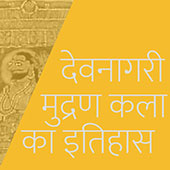The first stage of this project involved collection of data from various academic sources —papers, journals, blogs; my study relies on Bapurao Naik’s “Typography of Devanagari”—the book is comprehensive until a certain point in Devanagari’s time-line. After that, the guidance and works of Professor G V Sreekumar and Dr. Girish Dalvi, combined with references to reports by previous students at IDC that attempted to study various aspects of type-design brought to light newer perspectives and data.
This data has been analyzed and sifted through, in order to create a perspective that is accurate and free from bias. Content was created with focus on the message, regardless of medium. A time-line was created for the script right from its evolution from Brahmi until the creation of modern day type foundries such as Ek Type and Indian Type Foundry. The History of Devanagari has been traced through inscriptions, first attempts at hot metal printing in India and overseas during the colonial era, until current day where it is designed on a computer. Filling the gaps in the information to create a concise output has been the greatest challenge of this project.
In order to preserve the nuances of the script and not lose it to the constraints of technology, value has to be added to it by those who design. There is a direct need for designers in the field of script typeface design in this age of digitization and responsive web design. My project aims to inspire and provide a comprehensive reference point for such designers.
The report concludes with a set of typographic panels, that can be displayed at academic institutes or design gatherings attended by students and professionals alike.
Case Study Download:
• The History of Devanagari Typography......


